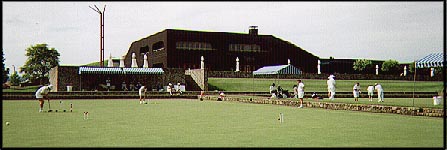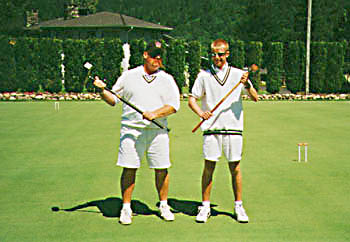

|
Back to |
| The Front Page |
| Archives |

| Sonoma-Cutrer and The Resort at the Mountain showcase world class International Rules play |
|
||||||||
|
by Bob Alman Posted May 15, 1998 |
|||||||||
If ever there was a year of complete British dominance of the sport of croquet, 1998 seems destined to be that year. The WCC's World Rankings have been in recent years a good predictor of the outcomes of world championship events. The British have a firm grip on the top of those rankings with five of the top six places, and every one of those five - Fulford, Clarke, Mulliner, Maugham, and Comish - will be at Sonoma-Cutrer in late May to play for the top prizes. The two Brits at the top who have traded the WCF world championship - Fulford and Clarke - will go on to play in Oregon's Resort at the Mountain Invitational in early June, with six other strong players from the U.S., Australia, and New Zealand.
Sonoma-Cutrer - the first and (in 1998) the only
The Sonoma-Cutrer World Championship is not officially sanctioned by the World Croquet Federation, though it was in fact the first genuine world singles championship to be mounted fourteen years ago (The first WCF world championship was held the following year). The Sonoma-Cutrer event is held every year, while the official world championship is not. And in 1998, the Sonoma-Cutrer World Championship is the only event to bring together from the major croquet playing countries the best available players to compete for a world title in singles.
 At Sonoma-Cutrer, all the play is on two courts surrounded by several tiers of stonework and grass terraces in front of the winery. |
Many top level players - especially the British - express further doubts about the legitimacy of a world championships event with so few games crammed into the six-day schedule on two lawns and which is decided on the basis of single games rather than best-of-three match play - as is customary in virtually every other major International Rules event in the world.
But these considerations pale in the presence of the most glamorous spectacle in the croquet world. The audacity of an event that brings 1200 spectators paying $160 for entry to watch a game they don't comprehend is one thing; but they go on to spend more than $400,000 at the day-long finals event in a wine auction benefit for Make-a-Wish Foundation. This is puzzling to many, especially overseas visitors who don't understand how "society" operates in America.
The Sonoma-Cutrer World Championship is a triumph of business acumen and publicity. In the end, it doesn't matter whether most of the spectators present understand what is being explained and amplified with patience and good humor by England's Richard Hilditch from his referee's throne in the corner of the championship court. The Northern California social calendar decrees that this is the place to be seen in late May of every year.
Croquet is not a good vehicle for fund-raisers in the British Commonwealth countries, where the public image of croquet is middle-class and elderly. In America, however, publicists can go for the gold with croquet as an "elegant and refined" sport worthy of the passing attention of the glitterati.
Where do the players fit into all this? They love it. The few players who decline an invitation do so with sincere regrets. The players from every country except the United States are chosen by the local associations themselves through their own organized processes. (For a brief period, this was also true in the United States, but the president of Sonoma-Cutrer abruptly severed the relationship with the United States Croquet Association a couple of years ago when the USCA process produced selections not to his liking.)
Though the players put up an entry fee of several hundred dollars, most of their other expenses are paid by the organizers. They are wined and dined fabulously. With only two courts to share for 28 players (eight players competing simultaneously, double-banked) there is much time off for exploring the wine country and for noshing at courtside. The glory of winning the event is further sweetened with a purse of several thousand dollars.
For the preliminary first five days of play, it's a quiet scene, with few visitors - mostly local croquet players and friends - and only the sharp clack of roquets and croquets, along with the occasional fly-over from a nearby airport to interrupt the peace of the rolling meadows and vineyards around the winery.
With so much croquet going on, even the idle players ignore much of the on- court action, but word gets around quickly when something notable is happening - a sextuple in progress or an interesting two-ball display or a dark horse peg-out of one of the favorites. Such moments occur often at Sonoma-Cutrer, because the lawns are notoriously "easy" - of smooth and uniform texture, allowing precision play - and the wickets (or "hoops" as they are called in other countries) are also relatively easy, as they are set in an all-sand surface and therefore yield easily to frequent and hard hitting.
What kind of play will arouse the most intense comment and speculation this year at Sonoma-Cutrer? Perhaps it will be the OTP - triple-peeling the opponent into the stake, reducing him to only one ball against your two. Though there is no firm consensus on the wisdom of this tactic, there is little doubt it will be seen frequently, and courtside pundits will produce rate-of-success statistics in support of their own theses on the subject.
 |
| The finalists of last year's Resort at the Mountain Invitational - Jerry Stark and Toby Garrison - are back again in 1998, against tougher competition. |
David Maugham - perhaps the most flamboyant of the British players - returns to the competition this year and will doubtless enliven the proceedings with some flashy moves.
Chris Clarke - who wowed the crowd last year in his finals game against Debbie Cornelius, pegging her first ball out and his own first ball as well with a virtually even hoop count and then gradually taking control of the game through superior stroke-making in the ensuing two-ball contest - will probably produce more demonstrations of his mastery of this strategy. (This usually plays out as a variation of OTP strategy, when the peeler is confident of his ability to prevail in a two-ball contest.)
World champion Robert Fulford, always looking for a sextuple - will seek new ways to push the envelope on Sonoma-Cutrer's easy lawns - perhaps with an octuple?
The format for the Sonoma-Cutrer is always the same: the "Patmor draw." The players are divided into four blocks of seven players each. The block play begins on Monday, May 25. First Place in each block proceeds to a Medalist Block of four players. Second, third, and fourth place in each block begin a single-life ladder playoff on Friday morning. After the Medalist block has finished, the players are seeded into the ladder, with Medalist 3rd and 4th playing late on Friday. The second-place Medalist is seeded into the quarter finals on Saturday morning and the Medalist 1st place becomes the "holder", with a guaranteed place in the final on Saturday afternoon.
The Sonoma-Cutrer player lineup
- AUSTRALIA
- Brett Hewitt
- Colin Pickering
- Max Merlin
- Helene Thurston
- Colin Pickering
- CANADA
- Graham Garlick
- ENGLAND
- Chris Clarke
- Steve Comish
- Debbie Cornelius
- Robert Fulford
- David Maugham
- Stephen Mulliner
- Steve Comish
- IRELAND
- Simon Williams
- Toby Garrison
- Toby Garrison
- NEW ZEALAND
- Peter Landrebe
- John Prince
- Chris Schilling
- Aaron Westerby
- John Prince
- SOUTH AFRICA
- Reg Bamford
- SCOTLAND
- John Surgenor
- UNITED STATES OF AMERICA
- Phil Arnold
- Jim Bast
- Jacques Fournier
- Don Fournier, Jr.
- Ren Kraft
- Michael Mehas
- Britt Ruby
- Jerry Stark
- Jim Bast
- WALES
- John Evans
The Resort At The Mountain Invitational - Oregon's second annual wine-and-croquet spectacle
Some of the best players at Sonoma-Cutrer will travel north for yet another prize-money spectacle on the slopes of Mount Hood, June 3-6. The Resort At The Mountain celebrated the opening of its two courts in Welches, Oregon, last year with an International Rules invitational for six players. This year, the event is bigger and better in most respects: more players, better players, more events and spectacle, expanded sponsorship, and even - for croquet - a decent purse of $4,250, of which the winner will carry away a $1500 share.
The tournament begins with a single 28-game round robin for the eight players in the first days, with the top six advancing to the money round. First and second place in the round robin play off, with the winner becoming the finalist "holder" and the loser playing the winner of a double-elimination ladder contested by the players who ended block play in places third through sixth.
The players are Robert Fulford and Chris Clarke from England; Aaron Westerby and Toby Garrison from New Zealand; Colin Pickering and Helene Thurston from Australia; and Jacques Fournier and Jerry Stark from the U.S.
The finals-day spectacle has been attractively packaged for non croquet players as a "Wine and Wickets" benefit for the newly formed Oregon Wine Archive and the Oregon Historical Society, beginning at 11:00 AM. The finals match climaxing the event, fully narrated for the benefit of spectators unfamiliar with the sport, is expected to end around 4:30 PM.
[Tickets costing $25.00 provide entre to all the June 6 finals day activities including lunch, a Pro-Am event, and a silent and oral auction. For information on tickets, call the Oregon Historical Society at 503-306-5229.]